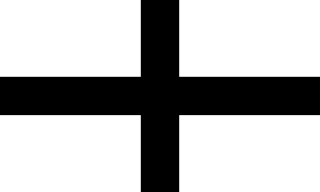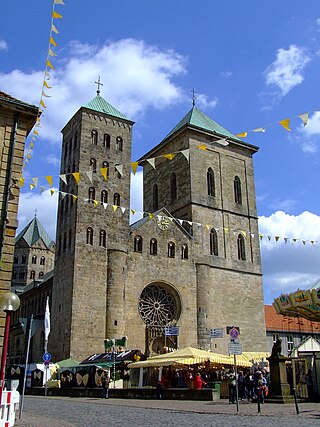
The Electorate of Cologne, sometimes referred to as Electoral Cologne, was an ecclesiastical principality of the Holy Roman Empire that existed from the 10th to the early 19th century. It consisted of the Hochstift—the temporal possessions—of the archbishop of Cologne, and was ruled by him in his capacity as prince-elector. There were only two other ecclesiastical prince-electors in the Empire: the Electorate of Mainz and the Electorate of Trier. The archbishop-elector of Cologne was also arch-chancellor of Italy and, as such, ranked second among all ecclesiastical and secular princes of the Empire, after the archbishop-elector of Mainz, and before that of Trier.

Friedrich Wetter is a German cardinal of the Catholic Church. He was Archbishop of Munich and Freising, Germany, from 1982 to 2007. He was Bishop of Speyer from 1968 to 1982. He has been a cardinal since 1985.
Bruno the Saxon, also known as Bruno of Merseburg or Bruno of Magdeburg, was a German chronicler of the eleventh century and author of the Historia de Bello Saxonico.

The Diocese of Osnabrück is a Latin Church ecclesiastical territory or diocese of the Catholic church in Germany. The diocese was originally founded circa 800. It should not be confused with the smaller Prince-Bishopric of Osnabrück–an ecclesiastical principality of the Holy Roman Empire until 1803–over which the bishop, as prince-bishop, exercised both temporal and spiritual authority.

The Metropolitan Archdiocese of Paderborn is a Latin Church archdiocese of the Catholic Church in Germany; its seat is Paderborn. It was a diocese from its foundation in 799 until 1802, and again from 1821 until 1930. In 1930, it was promoted to an archdiocese. From 1281 until 1802, the Bishopric of Paderborn was also a state of the Holy Roman Empire.

Joseph Höffner was a German cardinal of the Roman Catholic Church. He served as the Archbishop of Cologne from 1969 to 1987 and was elevated to the cardinalate in 1969.

The Archdiocese of Hamburg is a Latin Church ecclesiastical territory or diocese of the Catholic Church in the north of Germany and covers the Federal States of Hamburg and Schleswig-Holstein as well as the Mecklenburgian part of the Federal State of Mecklenburg-Vorpommern. In terms of surface area it is the largest in Germany. It is characterized by its situation as a diocese in the Diaspora. Seat of the archbishop is the New St. Mary's Cathedral in Sankt Georg, Hamburg. On January 26, 2015 Stefan Heße, Generalvikar of the Archdiocese of Cologne, was appointed Archbishop of Hamburg.

Johannes Joachim Degenhardt was the Roman Catholic Archbishop of Paderborn (Germany) from 1974 until his death in 2002. He was named Cardinal in 2001.
Ludwig Averkamp was a German prelate of the Catholic Church. He served as Bishop of Osnabrück from 1987 to 1994, and Archbishop of Hamburg from 1994 to 2002.

The Diocese of Münster is a Latin Church ecclesiastical territory or diocese of the Catholic Church in Germany. It is a suffragan diocese of the Archdiocese of Cologne. Bishop Felix Genn is the current bishop of the Diocese of Münster. He was ordained to the priesthood on 11 July 1976 and was appointed to the See of Münster on 19 December 2008.

Paul Josef Cordes was a German cardinal of the Roman Catholic Church. He served as president of the Pontifical Council Cor Unum (1995–2010) and was elevated to the rank of cardinal in 2007.

The Prince-Bishopric of Paderborn was an ecclesiastical principality (Hochstift) of the Holy Roman Empire from 1281 to 1802.

The Archdiocese of Strasbourg is a Latin Church ecclesiastical territory or archdiocese of the Catholic Church in France, first mentioned in 343 AD.

The Lübeck Martyrs were three Roman Catholic priests – Johannes Prassek, Eduard Müller and Hermann Lange – and the Evangelical-Lutheran pastor Karl Friedrich Stellbrink. All four were executed by beheading on 10 November 1943 less than 3 minutes apart from each other at Hamburg's Holstenglacis Prison. Eyewitnesses reported that the blood of the four clergymen literally ran together on the guillotine and on the floor. This impressed contemporaries as a symbol of the ecumenical character of the men's work and witness. That interpretation is supported by their last letters from prison, and statements they themselves made during their time of suffering, torture and imprisonment. "We are like brothers," Hermann Lange said.

Rainer Maria Woelki is a German Cardinal of the Catholic Church. He has been Archbishop of Cologne since his installation on 20 September 2014 following his election by the Cathedral Chapter to succeed Joachim Meisner in that position. He previously served as Archbishop of Berlin.

Franz-Peter Tebartz-van Elst is a German prelate of the Catholic Church and theologian. He was a vicar and an auxiliary bishop in Münster before becoming the Bishop of Limburg in January 2008. Pope Francis removed him from the exercise of his episcopal office on 23 October 2013 and on 26 March 2014 accepted his resignation as Bishop of Limburg, following a long-standing public dispute about the costs and financing of a diocesan construction project.

Stefan Heße is a German Catholic prelate who has served as Archbishop of Hamburg since 2015. The youngest diocesan bishop in Germany, he has often been outspoken on social and religious topics.
Thissen is a surname. Notable people with the surname include:

Peter Kohlgraf is a German Catholic prelate who has served as Bishop of Mainz since 2017.


















